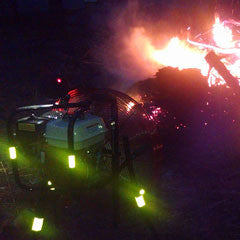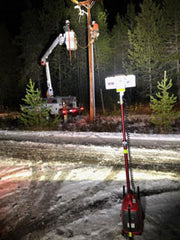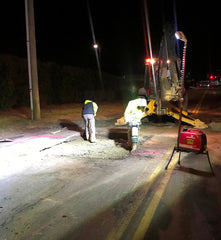What is the difference between a scene light and work light?
Light manufactures use various terms to describe their lights, including 'scene lighting,' 'site lighting,' 'work lights,' and 'task lights.' So what's the difference? What makes a light qualify as a scene/site light versus a work/task light?
The main difference between the scene/site and work/task lights is the size of the area they effectively light up.
If a light’s output is less than 10,000 lumens, it’s closer to being a flashlight or home improvement store work light than a scene light or site light. Many lights advertised as scene lighting should be categorize instead as work lights. A “work light” should reasonably illuminate an area less than about 200 square feet, occupied by one person doing a stationary task. Work lights might also be called portable personal lighting or task lighting.
In contrast, a true “scene light” or "site light" should light up a large area (an entire scene or site) as shown in the picture below.

This scene light, Lentry® Light Model 1SPECX, brightens up the whole construction site. Photo courtesy of KB Trade GmbH, Switzerland.
As an aside, the definition of “scene” or "site" depends on industry. For example, for those in fire, rescue, and public safety, a scene is the whole area involved in an accident, incident, or training event. A light deployed to illuminate such a scene should make visible everyone involved, not just one or two first responders. Examples of scenes a scene light should illuminate include: multiple cars in a motor vehicle accident; a multi-department evening training event; a residential structure fire; the area surrounding an emergency medical response trailer at a special event. These areas are measured in thousands of square feet, not hundreds.
For other industries like those in public works, utilities, oil and gas, rail, communications, military, construction... the same area previously described is often called a site, jobsite, or work site. Examples of sites a site light should illuminate include: storm cleanup or disaster recovery that stretches the length of a city block; the area around a broken water main; multiple spans of power lines; the top of a tall power pole, 50 feet in the air... Again, these are large areas more than a dozen feet in any direction.
Share this post
Latest News & Articles
Brush Burning Fans
Several of the unique qualities which make Ventry Fans ideal for fire fighting also make them a great investment for brush/slash burning. Contractors often want 4 or more brush burner fans for huge land clearing projects; they soon realize only one Ventry Fan is needed!

Photos compare lighting options for Linemen
Photos by local linemen: They tested safety lighting solutions during overhead pole work and trench work. Photos compare headlights, spotlight, and Lentry® Portable Lighting.

Lentry Lights make quick work of nighttime repairs
See how Lentry Light Systems with a single LED light head help utility companies see and be safer when having to work at night.

Stay in touch
CALL US
We’d love to hear from you and will be happy to answer your questions and assist you with our products. Call (888) 257-8967.
E-NEWSLETTER
Sign up here for our once-a-month email of GREAT NEWS!
